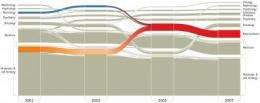Scientists map changes in science and beyond

How has the structure of scientific research changed over the past decade? A team of researchers from Umeľ University, Sweden, and the University of Washington, USA, aims to answer this question and others in a study published on January 27th in the online, open-access journal PLoS ONE.
Using new mathematical tools, the authors have revealed major shifts in the structure of scientific research in order to uncover structural changes in large, interconnected systems. To illustrate the power of their methods, the researchers mapped changes in the field of neuroscience and were able to track how the field evolved from an interdisciplinary specialty to a full fledged scholarly discipline.
"We wanted to map changes in science over the past decade. To do so, we started with more than 35 million citations between the articles in over 7000 scientific journals. This network of citations represents the flow of information between researchers in the world and the results show that significant changes have occurred in the life sciences. Neuroscience has gone from being an interdisciplinary research area to being a scientific discipline in its own right, ranking alongside physics, chemistry, economics, law, molecular biology and medicine," says Martin Rosvall, Assistant Professor at the Department of Physics, Umeľ University. This analysis has resulted in some striking images (featured in the article), which elegantly demonstrate the change in the discipline over time.
The key to understanding complex and integrated structures such as the scholarly research literature is to think of them as networks. In a network, the components of the system are represented by nodes, and the interactions between the components consist of links between the nodes.
"People have done a great deal of work on how to find the important features of a network at one specific point in time. But we have not had ways of looking at how these networks change over time," explains Rosvall.
"Detecting structural changes in large networks is a problem that consists of two parts," explains Carl Bergstrom, Professor at the Department of Biology, University of Washington. "First, we identify statistically significant changes in the structure of a network, and second, we provide an intuitive way to visualize these changes." These new tools will be useful in understanding a world permeated with change. As the pre-Socratic philosopher Heraclitus wrote over 2500 years ago: "Everything flows, nothing stands still."
The researchers believe that these mathematical methods will go beyond analyzing science and will be applied to a number of other problems in fields ranging from biology and medicine to technology and finance.
More information: Rosvall M, Bergstrom CT (2010) Mapping Change in Large Networks. PLoS ONE 5(1): e8694. doi:10.1371/journal.pone.0008694
Provided by Public Library of Science

















